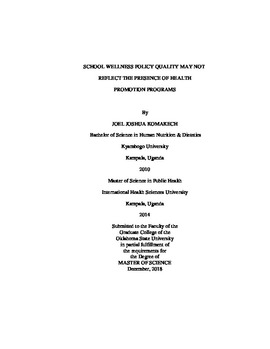| dc.contributor.advisor | Hildebrand, Deana A. | |
| dc.contributor.author | Komakech, Joel Joshua | |
| dc.date.accessioned | 2019-07-19T14:49:21Z | |
| dc.date.available | 2019-07-19T14:49:21Z | |
| dc.date.issued | 2018-12-01 | |
| dc.identifier.uri | https://hdl.handle.net/11244/320992 | |
| dc.description.abstract | Schools are an optimum environment to address children's health outcomes. Schools participating in federal Child Nutrition Programs are required to have a school wellness policy (SWP). Numerous organizations have developed health promotion programs to address school health environments through various approaches including nutrition services, nutrition and physical activity education and policy adoption. In general, research focusing on the presence of health promotion programs' relation to SWP is lacking. The purpose of this study was to determine the influence of presence of health promotion programs on the comprehensiveness and strength of SWPs in a sample of Oklahoma school districts during school years 2015 and 2016. | |
| dc.description.abstract | A sample of 344 school districts (63 percent) in the State of Oklahoma was used in this study. WellSAT 2.0 assessment tool was used to evaluate the strength and comprehensiveness of SWPs. Interrater reliability of 0.99 and 0.97 for SWP comprehensiveness and strength assessment tool was found for this study. School districts participation data in health promotion programs during our study period was collected from program websites and contact persons and the Oklahoma State Department of Education. ANOVA was used to compare means of SWP scores for each of the independent variables and chi-square was used to test for the difference in proportion between specific study variables. SWPs had a mean comprehensiveness score of 43.7 percent and mean strength score of 21.8 percent. Overall, school districts participated in a mean of 2.0 programs. There were no significant differences in comprehensiveness or strength scores by district geographic location (p =.68, p =.99, respectively), district type (p =.23, p =.42, respectively) or number (p =.50, p =.44 respectively), within (p ≥.11, p ≥.08, respectively) or between (p ≥.13, p ≥.22 respectively) types of health promotion programs. There was a difference in the proportion of health promotion programs in school districts by geographic setting ( p=.01) and district type ( p=.00). Presence of health promotion programs did not explain differences in quality of districts’ written SWP. When reviewing and revising SWPs, school districts should ensure that policies reflect practices and wellness programming within the district to improve SWP quality. | |
| dc.format | application/pdf | |
| dc.language | en_US | |
| dc.rights | Copyright is held by the author who has granted the Oklahoma State University Library the non-exclusive right to share this material in its institutional repository. Contact Digital Library Services at lib-dls@okstate.edu or 405-744-9161 for the permission policy on the use, reproduction or distribution of this material. | |
| dc.title | School Wellness Policy Quality May Not Reflect the Presence of Health Promotion Programs | |
| dc.contributor.committeeMember | Gates, Gail | |
| dc.contributor.committeeMember | Stoecker, Barbara J. | |
| osu.filename | Komakech_okstate_0664M_15945.pdf | |
| osu.accesstype | Open Access | |
| dc.description.department | Nutritional Sciences | |
| dc.type.genre | Thesis | |
| dc.type.material | Text | |
